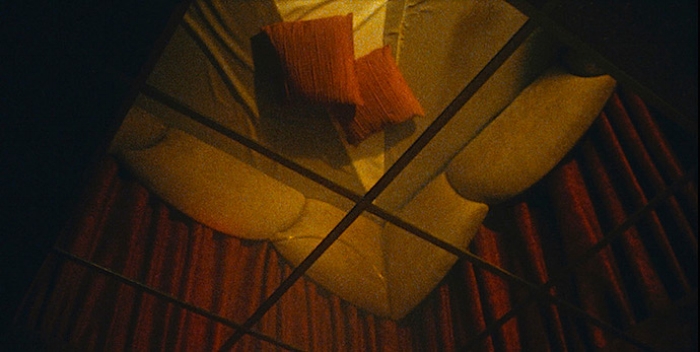“YOUNG AUSTRIAN AVANT-GARDE : THE FILMS OF FILMKOOP WIEN”
(Still image : The Pimp And His Trophies, 2014 – Antoinette Zwirchmayr)
MONDAY MAY 2, 2016 @ THE CENTER FOR PERFORMANCE RESEARCH
361 MANHATTAN AVENUE, BROOKLYN. OFF METROPOLITAN G OR LORIMER L
DOORS 7PM – SHOW at 7:30PM – $6 SUGGESTED DONATION – FILMS, DRINKS & DISCUSSION.
TRT, 50 minutes. Additional time for discussion / Q & A with artist Stefanie Weberhofer
Join us in welcoming Austrian artist Stefanie Weberhofer who will be sharing a program of moving image work created by members of the collective, Filmkoop Wien.
PROGRAM :
Filmkoop Wien trailer, Stefanie Weberhofer, 2015
(color, silent, 24fps, 16mm + double8 printed on 16mm, single framed, hand processed E6)
Golan, Viktoria Schmid, 2012
(b/w, sound, 24fps, 16mm + contact-printing, hand processed)
A contribution in the vein of the long-lasting tradition of picturing the horse as well as a portrait of a longtime companion of the filmmaker. In front of the camera the horse behaves differently than in other known images in art history. The audio is generated by contact-printing the picture information.
Handmade, Magdalena Pfeifer, 2012
(b/w & color, silent, 24fps, 16mm + found footage, hand processed, hand printed, hand-coloration)
Handmade refers to the film footage itself, underlining the importance of materiality in this oeuvre. You can see hands in motion that create, operate and do, however, without ever accomplishing their goal. The final result remains unclear. The found footage material used gets radical deconstructed.
Water from Grain, Josephine Ahnelt, 2013
(b/w, silent, 24fps, 16mm + Super8, b/w reversal, hand processed)
“The poetry of Water from Grain grows out of an apparent contradiction stemming from its seeming timelessness while it plays out on the clearly recognizable outskirts of Vienna in the years of 2011 and 2012. Josephine Ahnelt accompanies two youths, a boy and a girl, with her Super-8 camera. Her main interest is focused upon the woman, her subtle beauty and her shapely form. Black and white and silent, the film focuses upon the visual impact of fleeting moments employing lighting, facial expression and gesture rather than dialogue to conjure its atmosphere. The footage was hand processed and is hence blemished, the resulting impurities obscuring and transcending certain scenes. The first chapter unfolds at an airport. There where the longing for far away places and the other provides the stuff of fantasy the protagonists lean against the railing of a parking garage and gaze downwards, they pursue each other in a game of catch and the young woman poses in the shadow play of the concrete desert. She seems older than the young man, more thoughtful and closer to adulthood. Both seem to use this anonymous place of transitas a location for their freedom and curiosity, as a space for unsupervised movement.In the meantime, three other young people take happy and affectionate leave of a fourth person. They are older and have reason to be at the airport. The third chapter of the film also takes place in a public space, a small park that serves as a good meeting place for the two youths and their friends. Their physical enactment of tussling and necking are expressions of boredom as well as a youthful discovery of sensuality. Where does the trip of life lead? As viewers we know nothing about the protagonists, everything is a matter of projection and guessing: But it is precisely in this indirect, lyrical, documentary-like form that a voyeuristic enthusiasm for stories beyond pure representation finds nourishment.” – Brigitta Burger-Utzer
Apanhar Laranjas / Picking Oranges, Sílvia das Fadas, 2012
(color, sound,24fps, 16mm)
Untitled, Antoinette Zwirchmayr, 2012
(color, silent, 24fps, 16mm)
“Lit like the central figure on a stage the body, seen here as a quiet monument, fills out the frame. There’s a mud–and-flesh-colored silhouette, rounded, dreamlike and eventually resembling a softly shaped mountain range in a 1970s illustration. Small puffy clouds of steam hover across it. Through the fine mist of humidity exuding from beyond one corner of the frame, a porous landscape of skin draped in ample rings of flesh, can be made out. Before the shot changes to show a new perspective of the body-massif, it becomes clear that it belongs to a female figure, revealed in large fragments shot by shot, creating the impression of a living and breathing Venus of Willendorf, a kind of dormant volcano.” – Julia Dossi
Cinématographe, Rosa John
(b/w, silent, 24fps, Super8, stop-motion animation)
Mostly single-frame animation based on the graphic design elements promoting the first public cinema screening showing Lumière films in Vienna (Austria) 1896.
Wortgefecht, Magdalena Pfeifer, 2014
(b/w, silent, 24fps, Super8, emulsion lift-off)
Ferragosto, Alina Tretinjak, 2015
(b/w, silent, 18fps, Super8)
An Italian summer romance.
Look how beautiful the light moves, Stefanie Weberhofer, 2015
(color, silent, 24fps, Super8, cross processed)
In her house in Montreal Stefanie Weberhofer catches the last rays of the beautiful autumn light on Super8.
The Pimp And His Trophies, Antoinette Zwirchmayr, 2014
(color, sound, 35mm – will screen digitally)
Antoinette Zwirchmayr revisits her complex childhood memories of being the granddaughter of Salzburg’s most famous pimp.
ABOUT FILMKOOP WIEN:
Founded 2008 by filmmakers with a love for celluloid – the filmkoop wien offers unique in Austria the space and the equipment to make working on filmmaterial possible and affordable for everyone. Filmmakers’ cooperative supporting self-determined filmmaking, with a space to develop, work on and project 8mm, 16mm & 35mm filmmaterial by individuals. Filmkoop offers an equipment rental with focus on analog film and a space for screenings, discussions and collaborations.
MONO NO AWARE SCREENING SERIES:
The CONNECTIVITY THROUGH CINEMA series will present the work of artists, film-makers and curators who are traveling or presenting special interactive programs in-person. Our hope is to engage the community by showing work with a focus on post-screening discussion.


